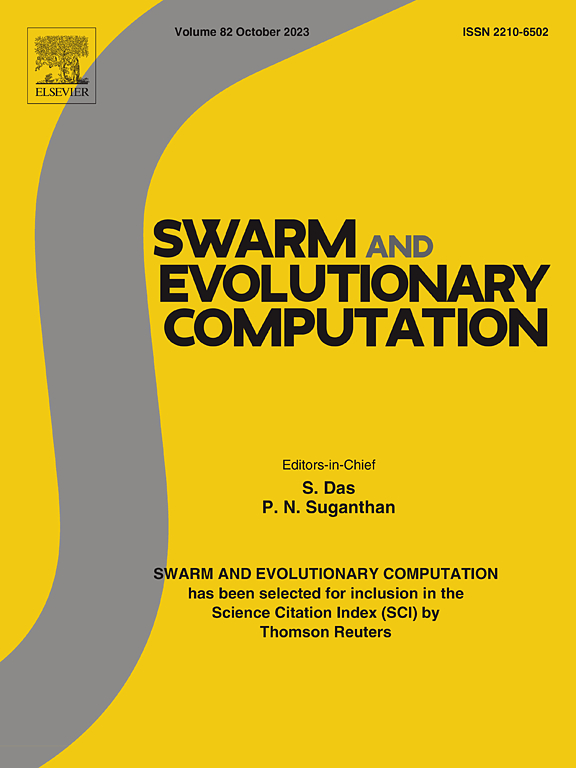DJAYA-RL: Discrete JAYA algorithm integrating reinforcement learning for the discounted {0-1} knapsack problem
IF 8.2
1区 计算机科学
Q1 COMPUTER SCIENCE, ARTIFICIAL INTELLIGENCE
引用次数: 0
Abstract
The JAYA algorithm is a swarm heuristic algorithm designed for solving continuous space problems. To apply it to the Discounted {0-1} Knapsack Problem (D{0-1}KP), it must be optimized into a discrete problem solving algorithm. Based on three decision vector encoding schemes for the D{0-1}KP, this paper discretely improves the JAYA algorithm using Q-learning and proposes three Discrete JAYA-RL (DJAYA-RL) algorithms: FirBJAYA-RL (the First Binary JAYA Algorithm Integrated with Reinforcement Learning), SimBJAYA-RL (the Simplified Binary JAYA Algorithm Integrated with Reinforcement Learning), and QJAYA-RL (the Quaternary JAYA Algorithm Integrated with Reinforcement Learning). Subsequently, a comparative analysis of the algorithm performance among the three DJAYA-RLs is conducted.
The DJAYA-RL algorithms utilize the Q-learning mechanism to adaptively control the number of grouped coding bits during individual updates. This enables the algorithms to explore the solution space in different regions more effectively. Meanwhile, the DJAYA-RL algorithms generate populations in different episodes by leveraging the information entropy of the historically optimal individual. This approach enhances the population diversity and helps avoid premature convergence.
Experimental results on the standard dataset of the D{0-1}KP demonstrate that the average solution errors of FirBJAYA-RL, SimBJAYA-RL, and QJAYA-RL are 1.1%, 0.15%, and 0.20% respectively. These results indicate that differences in encoding schemes have an impact on algorithm performance. Among the three encoding types, SimBJAYA-RL exhibits the best solution quality, while QJAYA-RL shows the best time performance. When compared with the genetic algorithm, firefly algorithm, and particle swarm algorithm for solving the D{0-1}KP, the average solution error rate of DJAYA-RL is significantly lower than that of the three swarm heuristic algorithms with corresponding encoding schemes. Moreover, compared with the three previously proposed discrete JAYA algorithms, the average solution error rate of the DJAYA-RL algorithm is significantly lower than that of the BJaya-JS, IBJA, and JayaX algorithms with corresponding encoding schemes.
DJAYA-RL:针对贴现{0-1}knapsack问题的整合强化学习的离散JAYA算法
JAYA算法是一种用于求解连续空间问题的群体启发式算法。为了将其应用于打折{0-1}背包问题(D{0-1}KP),必须将其优化为离散问题求解算法。基于D{0-1}KP的三种决策向量编码方案,本文利用Q-learning对JAYA算法进行离散改进,提出了三种离散JAYA- rl (DJAYA-RL)算法:FirBJAYA-RL(集成强化学习的第一二进制JAYA算法)、SimBJAYA-RL(集成强化学习的简化二进制JAYA算法)和QJAYA-RL(集成强化学习的第四纪JAYA算法)。随后,对三种DJAYA-RLs算法的性能进行了比较分析。DJAYA-RL算法利用Q-learning机制自适应地控制单个更新期间分组编码位的数量。这使得算法能够更有效地探索不同区域的解空间。同时,DJAYA-RL算法通过利用历史最优个体的信息熵,在不同的事件中生成种群。这种方法增强了种群多样性,有助于避免过早收敛。在D{0-1}KP标准数据集上的实验结果表明,FirBJAYA-RL、SimBJAYA-RL和QJAYA-RL的平均解误差分别为1.1%、0.15%和0.20%。这些结果表明,编码方案的差异会影响算法的性能。在三种编码类型中,SimBJAYA-RL表现出最好的解质量,QJAYA-RL表现出最好的时间性能。与求解D{0-1}KP的遗传算法、萤火虫算法和粒子群算法相比,DJAYA-RL算法的平均解错误率显著低于具有相应编码方案的三种群体启发式算法。此外,与之前提出的三种离散JAYA算法相比,DJAYA-RL算法的平均解错误率明显低于相应编码方案的BJaya-JS、IBJA和JayaX算法。
本文章由计算机程序翻译,如有差异,请以英文原文为准。
求助全文
约1分钟内获得全文
求助全文
来源期刊

Swarm and Evolutionary Computation
COMPUTER SCIENCE, ARTIFICIAL INTELLIGENCEC-COMPUTER SCIENCE, THEORY & METHODS
CiteScore
16.00
自引率
12.00%
发文量
169
期刊介绍:
Swarm and Evolutionary Computation is a pioneering peer-reviewed journal focused on the latest research and advancements in nature-inspired intelligent computation using swarm and evolutionary algorithms. It covers theoretical, experimental, and practical aspects of these paradigms and their hybrids, promoting interdisciplinary research. The journal prioritizes the publication of high-quality, original articles that push the boundaries of evolutionary computation and swarm intelligence. Additionally, it welcomes survey papers on current topics and novel applications. Topics of interest include but are not limited to: Genetic Algorithms, and Genetic Programming, Evolution Strategies, and Evolutionary Programming, Differential Evolution, Artificial Immune Systems, Particle Swarms, Ant Colony, Bacterial Foraging, Artificial Bees, Fireflies Algorithm, Harmony Search, Artificial Life, Digital Organisms, Estimation of Distribution Algorithms, Stochastic Diffusion Search, Quantum Computing, Nano Computing, Membrane Computing, Human-centric Computing, Hybridization of Algorithms, Memetic Computing, Autonomic Computing, Self-organizing systems, Combinatorial, Discrete, Binary, Constrained, Multi-objective, Multi-modal, Dynamic, and Large-scale Optimization.
 求助内容:
求助内容: 应助结果提醒方式:
应助结果提醒方式:


